Chapter 21
Curation Tools
“There are more things in heaven and earth, Horatio.”
Hamlet

Finding great content is key to building your personal brand and to keep it soaring in the social stratosphere on Twitter and your other social platforms. Finding a continual flow of exciting and informative content for your personal brand show can, however, be a time-consuming and stressful activity if not approached in the right way.
This chapter to showcases what I believe are the best tools for the job. Those that will make your curation a breeze and ensure that your content is always fresh, relevant, informative, and entertaining. Even better is that, with the exception of Intigi, they are free to use.
Blog Alternatives
A great website or blog that updates its readers with a new flow of information is something that every personal brand needs, but there are some of us who shy away from the prospect of writing a new blog post every couple of days. Some struggle with writing, while others simply can’t find the time to research and write new material on a continual basis. Either way, there are several great tools available that take the hard work out of putting together a great online publication that readers can subscribe to and that you can use to promote your personal brand through, using cross-platform promotion (CPP) with Twitter
Storify
Storify (shown in Figure 21-1) is a free tool that lets you curate content to tell stories using social media such as tweets, photos, and videos. It lets you search multiple social networks from one place and then drag individual elements into your story. You can then reorder the elements and also add text to give context to your readers. Storify is a very useful content-curation tool that also crosses the border into the realm of blogging and online publication, where you are, in effect, creating your own personal-brand magazine.
Figure 21-1
Storify lets you easily source content from around the web and lay it out in story form to share with your followers.

Scoop.it
Scoop.it (see Figure 21-2) is a new form of publishing-by-curation platform. Use the dashboard to manage multiple sources, including websites, RSS feeds, and social media accounts, and plug in relevant keywords and date parameters for more refined searching. Scoop.it is another free tool that provides a blog-alternative, letting you produce a customized content magazine for your followers.
Figure 21-2
Scoop.it lets you create a personal-brand magazine and is a great and easy alternative to setting up a blog.

Paper.li
Paper.li (see Figure 21-3) is my newspaper creator of choice. I use it to produce my web daily “newspaper,” The @grattongirl Review, which since its launch has quickly grown in subscribers, with articles retweeted more than 100,000 times. Essentially, Paper.li is a free content-curation service that lets you publish your own personally named newspaper based on your personal-brand topics of interest. It lets your followers subscribe to it and delivers a fresh edition to them every day via an e-mail or tweet.
Figure 21-3
Paper.li is a great newspaper-creation blog alternative tool for your personal brand.
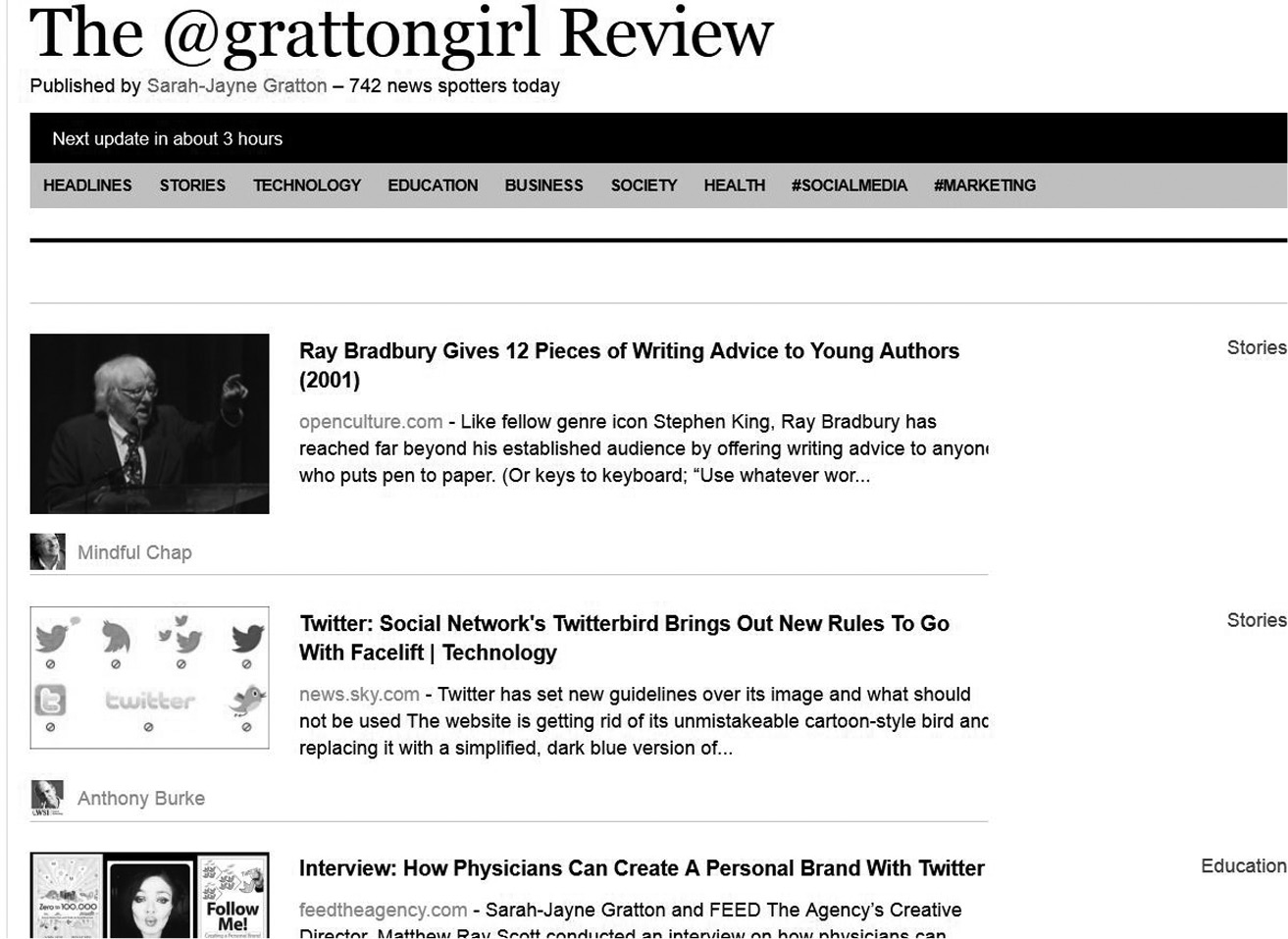
Twylah
Twylah (see Figure 21-4) is a free, auto-generated tool that bases your magazine on what’s currently trending in your Twitter stream. It relies on tweets sent by or featuring you, so it’s best used when your Twitter account is up and running and when you have established a good stream of content. It’s easy to use because it does all the work for you, picking the tweets that others are talking about and sharing.
Twylah also lets you send what it calls a power tweet, where your tweet leads others to its own page on Twylah, so it acts as a showcase for your Twylah publication, encouraging people to enjoy and share more of your content.
Figure 21-4
Twylah auto-generates a magazine that showcases your trending tweets
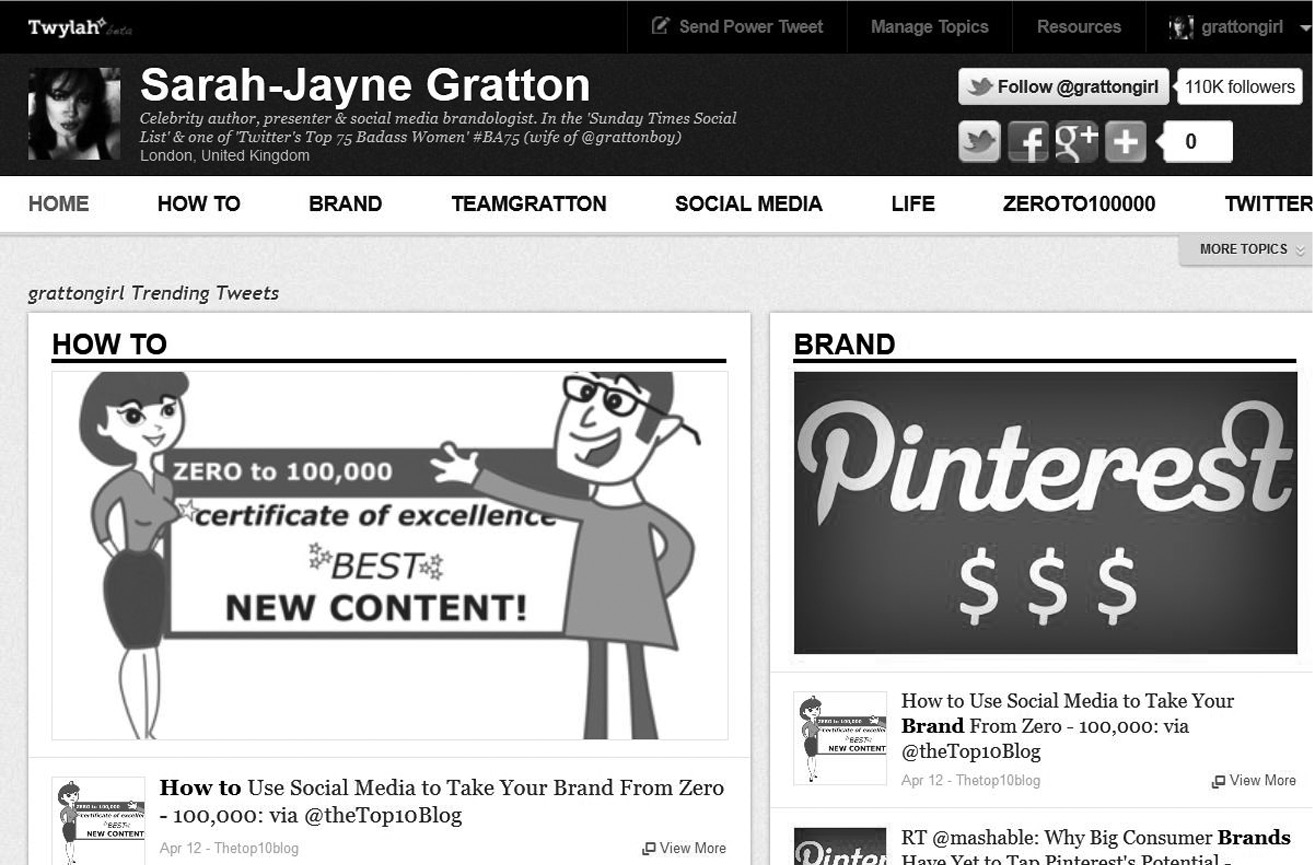
Content Search Tools
I like to think of the following curation tools as intelligent search engines that let you quickly find and tailor content for your Twittertorial calendar. They all vary in features and ease of use, but all are highly effective in what they do.
YourVersion
Unlike traditional search engines, the free YourVersion (see Figure 21-5) is optimized to provide real-time updates tailored to your specific interests on a continuous basis. The YourVersion team likes to call it a “discovery engine.”
YourVersion pulls together the most recent online gems related to your interests without requiring all that searching. Adding an interest like “iPhone” in YourVersion brings you not only the latest news on apps, but also includes blog posts, web pages, tweets, and videos. And you don’t have to type “iPhone” in again; next time you visit YourVersion, the latest iPhone stories are waiting for you.
YourVersion lets you enter and save any interest in your profile. It’s incredibly easy to use and lets you personalize your results in numerous ways. If you enter your keyword-based interests, YourVersion scours the web and blends discovered content into one easy-to-manage dashboard organized into tabs such as News, Blogs, Web, Twitter, Quora, and Friends. Use the Relevant versus Recent dial to get the right blend of content to share with your followers.
Figure 21-5
YourVersion provides real-time updates tailored to your specific interests.
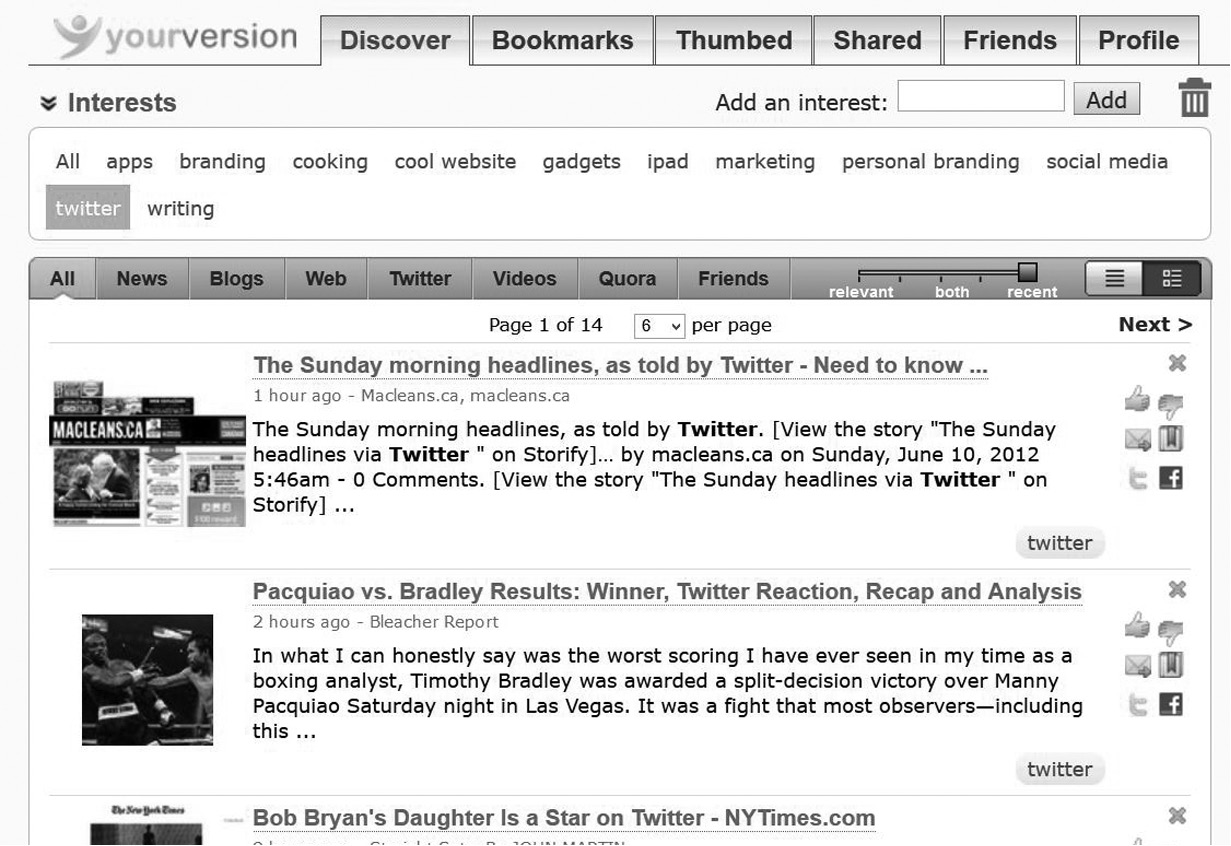
Intigi
Intigi was founded in 2011 by Jeff Ward, Joachim Hund, and Michael J. Fern, who were seeking to conduct content marketing for their software development and consulting businesses. Its goal is to reduce the friction in content marketing so that brands can focus their efforts on creating and curating valuable content for their followers.
With Intigi, you can set up interests using keywords. You can then monitor your favorite blogs and news sources, your Twitter accounts, and 30,000 online sources curated by Intigi users. It’s then easy to organize your interests into folders. For example, you might create separate folders for content marketing, intelligence gathering (including industry trends and competitor information), and personal interests.
Search results can be filtered by different time windows, such as 24 hours or 7 days, and sorted by relevance or date. Sources can be limited to just your own or to all those available through Intigi.
Intigi’s pricing starts at $9 per month for individuals, $19 for small businesses, and $49 for larger businesses and agencies; there’s a 14-day free trial available.
Marginize
Marginize (see Figure 21-6) is a free browser plugin that augments every page on the web with a sidebar that lets users see what the world is saying about that page on Twitter and Facebook and interact with each other through comments and check-ins.
Not only is Marginize an innovative way to share content through Twitter, it’s also a compelling way to create an online profile of where you have been. Think of it as a virtual version of Foursquare that lets you check in on websites or web pages that you go to. Each time you share an article, share a web page, or just have something that you want to say on a site, you are documenting your online footprint and, as with Foursquare, winning badges along the way.
Ultimately Marginize is a lot of fun and provides a way of sharing newly discovered web content with your followers.
Figure 21-6
Marginize is the web browser equivalent of Foursquare and a fun way to share new content with your followers while mapping your virtual footprint.
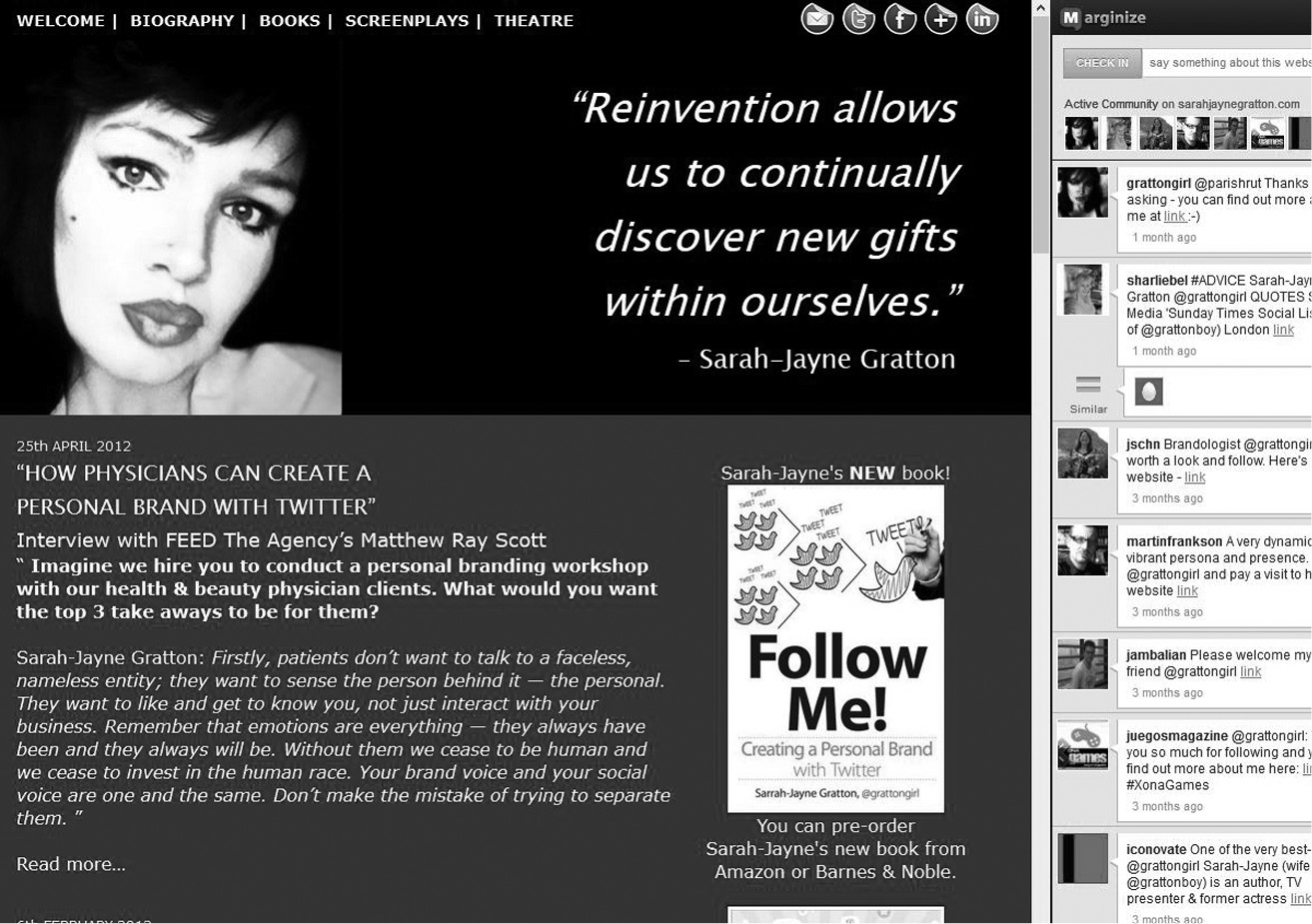
StumbleUpon
StumbleUpon (see Figure 21-7) is an intelligent, free content browser that builds on your interests and preferences to locate great online content for you to share with your followers. You can save your favorites and tell it what you want to see less or more of by clicking the thumbs-down or thumbs-up buttons, respectively.
My only criticism of the tool is that some of the content located can be quite dated, so be sure to check the relevance before you include it in your Twittertorial calendar.
Figure 21-7
StumbleUpon is a long-standing favorite tool for content curation.
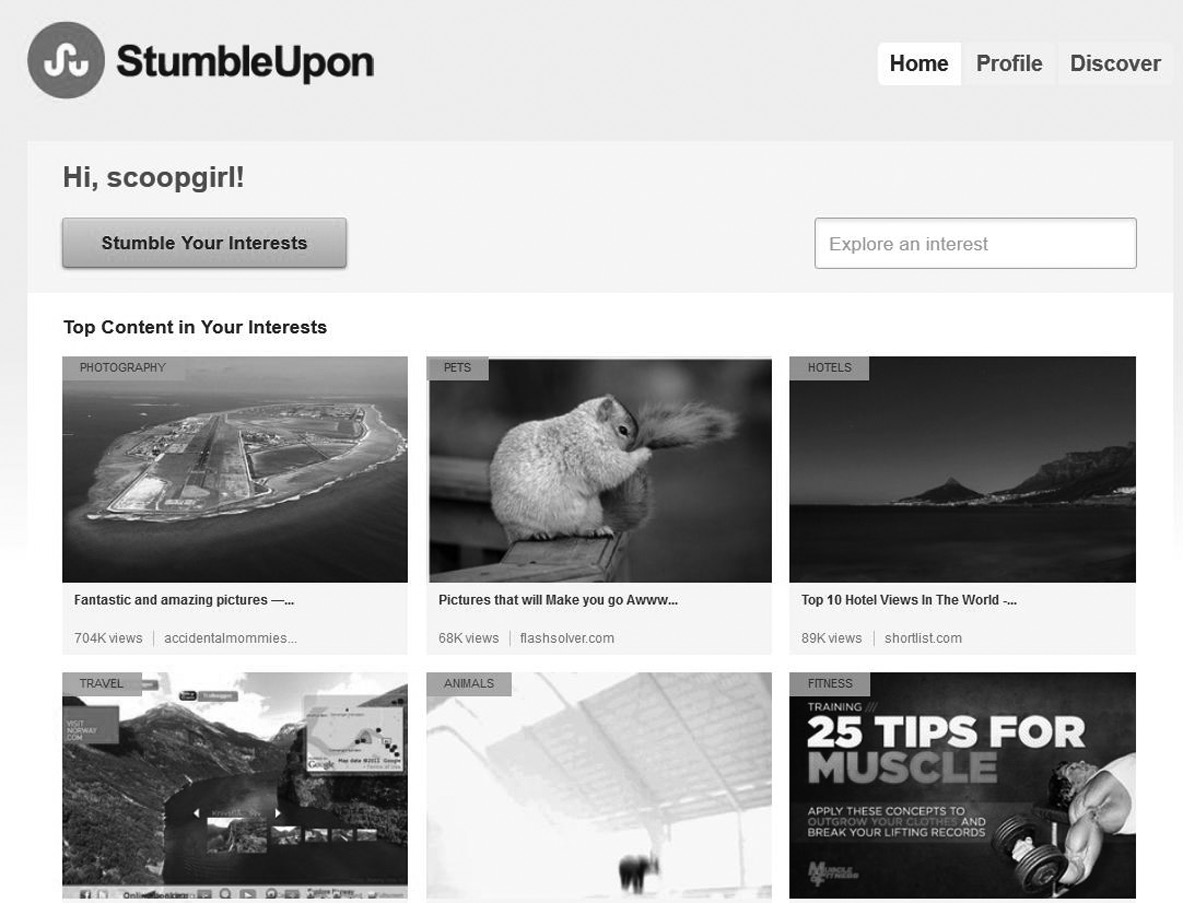
Tweet-Specific Tools
Sometimes, you want to assemble content from specific tweets. That’s what these next two tools let you do.
Chirpstory
Chirpstory (see Figure 21-8) is a free, tweet-specific curation tool for telling and sharing stories from Twitter. You can organize favorite tweets, conversations, and themed hashtags together to create fun and easy-to-read narratives out of the Twitter experience. Simply drag tweets into a timeline, edit the results, and then share your “story” with the world.
Figure 21-8
Chirpstory provides a tweet-focused curation experience.

Bag the Web
Bag the Web provides powerful, free web content capture in what it terms bags, which are assembled and linked to form collections of easily managed and sharable web content. The idea is simple and innovative — a bag can be filled with any topic and can also link to other relevant bags as references for particular content.
A bag takes just a few seconds to create. Just click the Create tab, add a title, and add a description; voilà, your bag is ready. If you want to keep a bag for personal use only, you can create it as private.
You can additionally copy and paste a web page’s URL into the link adding box and keep it in any bag you create.
To make a bag even more powerful and useful you can add more links to other relevant bags. The tool also contains a very useful bookmarklet, which is a convenient tool you can add to your browser toolbar so you can add any web page you visit to any bag you create simply by clicking it.

